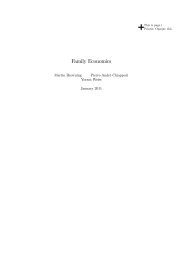Bounded Rationality in Industrial Organization
Bounded Rationality in Industrial Organization
Bounded Rationality in Industrial Organization
You also want an ePaper? Increase the reach of your titles
YUMPU automatically turns print PDFs into web optimized ePapers that Google loves.
unique equilibrium and the disequilibrium dynamics can feature a slow evolution along the<br />
near equilibrium set.<br />
6 The New Behavioral IO: Biases from Psychology and Economics<br />
The recent surge of <strong>in</strong>terest <strong>in</strong> bounded rationality <strong>in</strong> <strong>in</strong>dustrial organization comes on the<br />
heels of a bigger and slightly less recent surge of <strong>in</strong>terest <strong>in</strong> psychology and economics. This<br />
literature has by now documented a plethora of ways <strong>in</strong> which real consumers depart from<br />
the rational self-<strong>in</strong>terested ideal: they discount <strong>in</strong> a nonexponential manner, exhibit loss<br />
aversion; care about fairness; have self-serv<strong>in</strong>g biases; fail to update <strong>in</strong> a fully Bayesian<br />
manner, etc. More importantly, it has developed a number of simple models that can be<br />
adopted as representations of agents subject to such biases. Exactly how portable such<br />
models are is subject to debate, but at least <strong>in</strong> pr<strong>in</strong>ciple one can construct the behavioralbias<br />
counterpart of a given rational model by replac<strong>in</strong>g the utility maximization assumption<br />
with the assumptions of one’s favorite representation of consumers subject to this behavioral<br />
bias.<br />
The <strong>in</strong>itial papers <strong>in</strong> this branch of the behavioral IO literature have tended to focus<br />
on how firms will choose prices and product characteristics to exploit behavioral biases and<br />
whether competition will elim<strong>in</strong>ate the exploitation. Comb<strong>in</strong><strong>in</strong>g the IO and psychology and<br />
economics literatures, however, naturally gives many more than just one paper topic per<br />
bias – we can get a whole matrix of paper topics. Th<strong>in</strong>k of the set of behavioral biases as the<br />
column head<strong>in</strong>gs, and put all of the standard models <strong>in</strong> IO as the row head<strong>in</strong>gs: how will a<br />
monopolist price, how will a monopolist sell<strong>in</strong>g durable goods price; how will a monopolist<br />
price discrim<strong>in</strong>ate; how will oligopolists sell<strong>in</strong>g differentiated goods set prices; how will<br />
some action be distorted to deter or accomodate entry, etc. It takes little knowledge or<br />
imag<strong>in</strong>ation to come up with literally thousands of paper topics: Tirole’s (1988) text has<br />
hundreds of IO models, each of which could be comb<strong>in</strong>ed with dozens of behavioral-bias<br />
models.<br />
28













